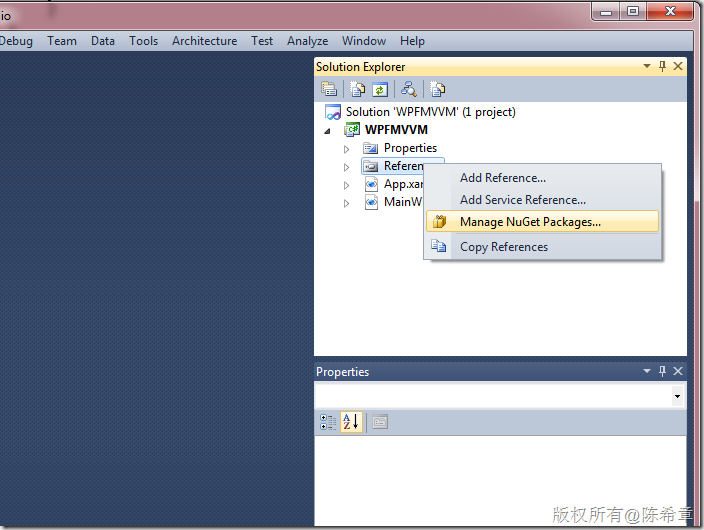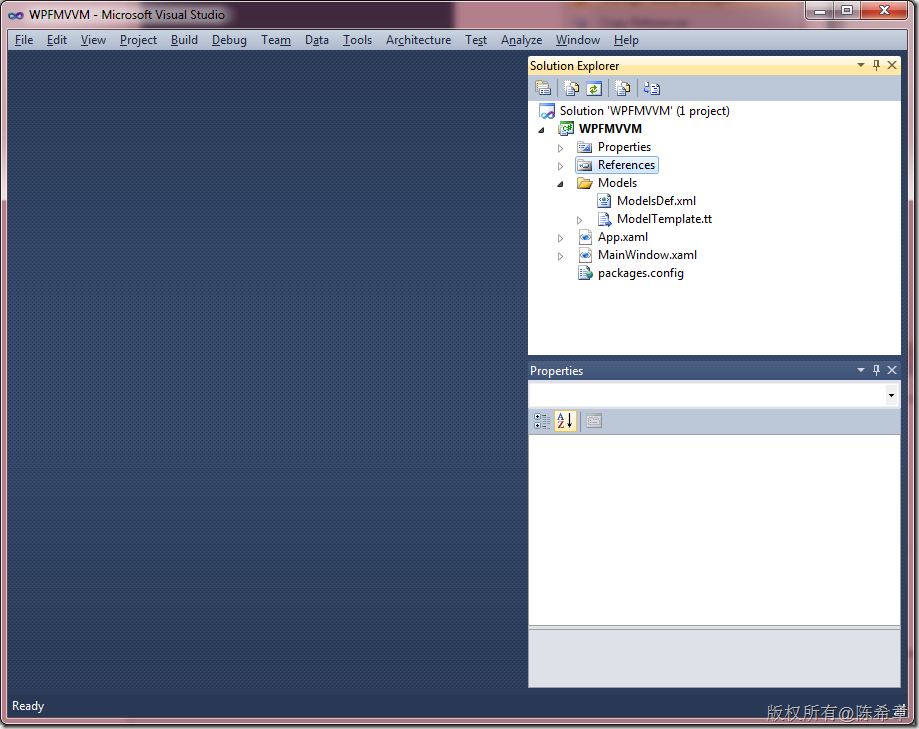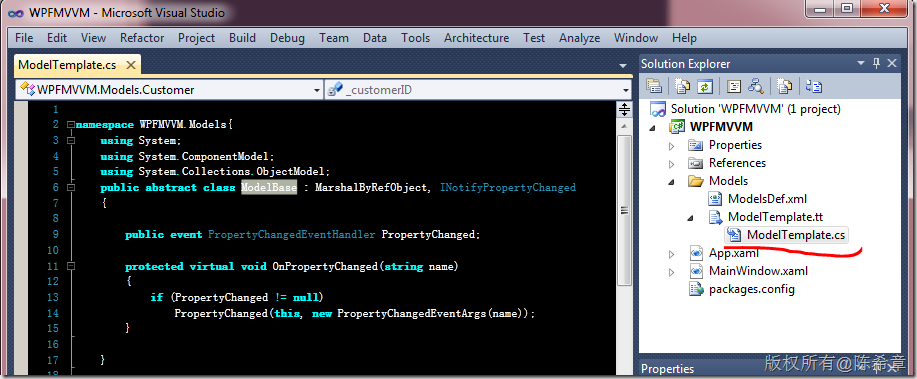在之前的两篇文章,我针对MVVM项目实践中如何简化Model和ViewModel类型的编码工作,提供了两种不同的方法。它们分别是
这一篇是这个话题的最后一篇,将提供第三种方法。
我们的思路就是,AOP和Interception都是需要做代码注入的,它们的使用也或多越少会有一些特殊的要求,例如Interception这种做法,它将使得我们无法直接通过new的方式创建Model的实例。那么是否可以有办法不进行这些复杂的步骤,而只是通过一些自动化的方式来生成我们需要的Model类型代码呢?
答案是:有。在Visual Studio 2010中全新支持的t4模板将很好地支持这一点。我记得多年前,我用过CodeSmith等一些工具生成代码,感觉还是不错的。但这些工具或多或少都需要收费,现在Visual Studio 2010既然内置支持代码生成,对我们来说绝对是一个好消息。
关于t4模板,以及一些基本概念,请参考
http://msdn.microsoft.com/en-us/library/bb126445.aspx
好了,我介绍一下我编写的这个模板吧。我的思路是这样的
1. 通过一个XML文件,定义项目中所需要的Model类型以及他们的属性
2. 通过一个t4模板,读取该XML文件,并且生成所有有关的Class,包括ModelBase,和每个Model
第一步,定义XML文件(我称其为ModelsDef文件)
xml version="1.0" encoding="utf-8" ?>
<ModelsDef>
<Model name="Customer">
<Property name="CustomerID"/>
<Property name="CompanyName"/>
Model>
<Model name="Order">
<Property name="OrderID" type="int"/>
<Property name="OrderDate" type="DateTime"/>
<Property name="CustomerID"/>
<Property name="Items" type="Collection" collectionType="OrderItem"/>
Model>
<Model name="OrderItem">
<Property name="OrderID" type="int"/>
<Property name="ProductName"/>
<Property name="UnitPrice" type="decimal"/>
<Property name="Quantity" type="int"/>
Model>
<xs:schema
xmlns:xs="http://www.w3.org/2001/XMLSchema">
<xs:element name="ModelsDef">
<xs:complexType>
<xs:sequence>
<xs:element name="Model" minOccurs="1" maxOccurs="unbounded">
<xs:complexType>
<xs:sequence>
<xs:element name="Property" minOccurs="1" maxOccurs="unbounded">
<xs:complexType>
<xs:attribute name="name" type="xs:string" use="required" />
<xs:attribute name="type" type="systemTypes" default="string" />
<xs:attribute name="collectionType" type="xs:string" use="optional" />
xs:complexType>
xs:element>
xs:sequence> <xs:attribute name="name" type="xs:string" use="required" />
xs:complexType>
xs:element>
xs:sequence> <xs:attribute name="baseClass" type="xs:string" default="ModelBase" />
xs:complexType>
xs:element> <xs:simpleType name="systemTypes"> <xs:restriction base="xs:string"> <xs:enumeration value="string">
xs:enumeration> <xs:enumeration value="int">
xs:enumeration> <xs:enumeration value="decimal">
xs:enumeration> <xs:enumeration value="double">
xs:enumeration> <xs:enumeration value="DateTime">
xs:enumeration> <xs:enumeration value="Collection">
xs:enumeration>
xs:restriction>
xs:simpleType>
xs:schema>
ModelsDef>定义好了一个XSD Schema(这是为了便于使用,在Visual Studio中可以提供智能提示),并且提供了几个Model的范例。
第二步,定义一个t4模板
<#@ template debug="false" hostspecific="true" language="C#" #>
<#@ output extension=".cs" #>
<#@ assembly name="System.Core.dll" #>
<#@ assembly name="System.Xml" #>
<#@ assembly name="System.Xml.Linq" #>
<#@ assembly name="EnvDTE" #>
<#@ import namespace="EnvDTE" #>
<#@ import namespace="System" #>
<#@ import namespace="System.Linq" #>
<#@ import namespace="System.Xml.Linq" #>
<#
/*
MVVM业务实体代码生成模板
作者:陈希章
时间:2011年6月
说明:这个模板会读取一个XML文件,并且根据该文件定义生成业务实体代码。该文件有规定的架构。请参考ModelsDef.xml
反馈:ares@xizhang.com
*/
string defaultNamespace =string.Empty;//这里可以替换为你需要的命名空间,如果不指定,则自动获取当前项目的命名空间下面,再加一个Models的子空间
string definitionFile ="ModelsDef.xml";//这是默认的定义文件,可以替换掉
IServiceProvider serviceProvider = (IServiceProvider)this.Host;
DTE dte = serviceProvider.GetService(typeof(DTE)) as DTE;
try{
definitionFile = Host.ResolvePath(definitionFile);
Project p = ((Array)dte.ActiveSolutionProjects).GetValue(0) as Project;
if(string.IsNullOrEmpty(defaultNamespace))
defaultNamespace=p.Properties.Item("RootNamespace").Value.ToString()+".Models";
var doc = XDocument.Load(Host.ResolvePath(definitionFile));
string baseClass= this.GetAttributeValue(doc.Root,"baseClass","ModelBase");
#>
namespace <#= defaultNamespace #>{
using System;
using System.ComponentModel;
using System.Collections.ObjectModel;
public abstract class <#= baseClass #> : MarshalByRefObject, INotifyPropertyChanged
{
public event PropertyChangedEventHandler PropertyChanged;
protected virtual void OnPropertyChanged(string name)
{
if (PropertyChanged != null)
PropertyChanged(this, new PropertyChangedEventArgs(name));
}
}
<#
foreach (var item in doc.Root.Elements("Model"))
{
string modelName =this.GetAttributeValue(item,"name",string.Empty);
if(string.IsNullOrEmpty(modelName))continue;#>
public class <#= modelName #> : <#= baseClass #>
{<#
foreach (var property in item.Elements("Property"))
{
string propName =this.GetAttributeValue(property,"name",string.Empty);
string type =this.GetPropertyTypeString(property);
string fieldName = string.Format("_{0}",propName.First().ToString().ToLower()+propName.Substring(1));
if(string.IsNullOrEmpty(propName))continue;#>
private <#= type #> <#= fieldName #>;
public <#= type #> <#= propName #>
{
get{return <#= fieldName #>;}
set{
if(<#= fieldName #>!=value){
<#= fieldName #>=value;
OnPropertyChanged("<#= propName #>");
}
}
}
<#}#>
}
<#
}
#>}<#
}
catch(Exception ex){
Write(ex.Message);
Error(ex.Message);
}
#>
<#+
public string GetAttributeValue(XElement element,string attr,string defaultValue){
return element.Attribute(attr)!=null?element.Attribute(attr).Value:defaultValue;
}
public string GetPropertyTypeString(XElement element){
var type = this.GetAttributeValue(element,"type","string");
var collectionType = this.GetAttributeValue(element,"collectionType",string.Empty);
if(type=="Collection"){
return string.Format("ObservableCollection<{0}>",collectionType);
}
else
return type;
}
#>
这个模板的原理是,读取模板文件同一个目录下面的ModelsDef.xml文件,并且生成全部的代码。下面是一个例子
namespace ConsoleApplication1.Models{
using System;
using System.ComponentModel;
using System.Collections.ObjectModel;
public abstract class ModelBase : MarshalByRefObject, INotifyPropertyChanged
{
public event PropertyChangedEventHandler PropertyChanged;
protected virtual void OnPropertyChanged(string name)
{
if (PropertyChanged != null)
PropertyChanged(this, new PropertyChangedEventArgs(name));
}
}
public class Customer : ModelBase
{
private string _customerID;
public string CustomerID
{
get{return _customerID;}
set{
if(_customerID!=value){
_customerID=value;
OnPropertyChanged("CustomerID");
}
}
}
private string _companyName;
public string CompanyName
{
get{return _companyName;}
set{
if(_companyName!=value){
_companyName=value;
OnPropertyChanged("CompanyName");
}
}
}
}
public class Order : ModelBase
{
private int _orderID;
public int OrderID
{
get{return _orderID;}
set{
if(_orderID!=value){
_orderID=value;
OnPropertyChanged("OrderID");
}
}
}
private DateTime _orderDate;
public DateTime OrderDate
{
get{return _orderDate;}
set{
if(_orderDate!=value){
_orderDate=value;
OnPropertyChanged("OrderDate");
}
}
}
private string _customerID;
public string CustomerID
{
get{return _customerID;}
set{
if(_customerID!=value){
_customerID=value;
OnPropertyChanged("CustomerID");
}
}
}
private ObservableCollection
_items;
public ObservableCollection
Items
{
get{
return _items;}
set{
if(_items!=
value){
_items=
value;
OnPropertyChanged(
"Items");
}
}
}
}
public
class OrderItem : ModelBase
{
private
int _orderID;
public
int OrderID
{
get{
return _orderID;}
set{
if(_orderID!=
value){
_orderID=
value;
OnPropertyChanged(
"OrderID");
}
}
}
private
string _productName;
public
string ProductName
{
get{
return _productName;}
set{
if(_productName!=
value){
_productName=
value;
OnPropertyChanged(
"ProductName");
}
}
}
private
decimal _unitPrice;
public
decimal UnitPrice
{
get{
return _unitPrice;}
set{
if(_unitPrice!=
value){
_unitPrice=
value;
OnPropertyChanged(
"UnitPrice");
}
}
}
private
int _quantity;
public
int Quantity
{
get{
return _quantity;}
set{
if(_quantity!=
value){
_quantity=
value;
OnPropertyChanged(
"Quantity");
}
}
}
}
}
看起来还不错,不是吗?那么,你将如何获得这个模板,以及在你的项目中使用呢?
其实很简单,你可以在Nuget gallary中找到我发布的这个Package。
如果你对Nuget不了解,请参考 http://www.nuget.org/
在项目中,”Manage NuGet Packages…”
用“MVVM_ModelEntity”作为关键字进行搜索
点击“Install”,这个工具会在你的项目中创建一个Models目录,并且添加两个文件
选择“ModelTemplate.tt”,然后”Run Custom Tool”
然后,你可以去查看ModelTemplate.cs文件
有兴趣的朋友,赶紧试试看吧











 本文介绍了一种通过定义XML文件和使用Visual Studio 2010的t4模板来自动化生成MVVM项目中Model类的方法。作者首先定义了一个XML文件(ModelsDef)来描述Model类型及其属性,然后编写了一个t4模板,该模板读取XML文件并生成相应的ModelBase类和各个Model类。这种方法避免了AOP和Interception带来的复杂性,使得可以通过简单的自动化方式生成所需代码。
本文介绍了一种通过定义XML文件和使用Visual Studio 2010的t4模板来自动化生成MVVM项目中Model类的方法。作者首先定义了一个XML文件(ModelsDef)来描述Model类型及其属性,然后编写了一个t4模板,该模板读取XML文件并生成相应的ModelBase类和各个Model类。这种方法避免了AOP和Interception带来的复杂性,使得可以通过简单的自动化方式生成所需代码。























 被折叠的 条评论
为什么被折叠?
被折叠的 条评论
为什么被折叠?








